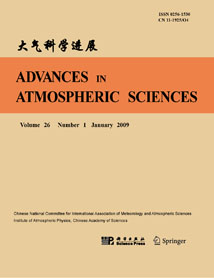| [1] |
GAO Lijie, ZHANG Meigen, HAN Zhiwei,
2009: Model Analysis of Seasonal Variations in Tropospheric Ozone and Carbon Monoxide over East Asia, ADVANCES IN ATMOSPHERIC SCIENCES, 26, 312-318.
doi: 10.1007/s00376-009-0312-9
|
| [2] |
XIE Fei, LI Jianping, TIAN Wenshou, ZHANG Jiankai, SHU Jianchuan,
2014: The Impacts of Two Types of El Nio on Global Ozone Variations in the Last Three Decades, ADVANCES IN ATMOSPHERIC SCIENCES, 31, 1113-1126.
doi: 10.1007/s00376-013-3166-0
|
| [3] |
ZHANG Meigen, XU Yongfu, Itsushi UNO, Hajime AKIMOTO,
2004: A Numerical Study of Tropospheric Ozone in the Springtime in East Asia, ADVANCES IN ATMOSPHERIC SCIENCES, 21, 163-170.
doi: 10.1007/BF02915702
|
| [4] |
Samuel Takele KENEA, Young-Suk OH, Jae-Sang RHEE, Tae-Young GOO, Young-Hwa BYUN, Shanlan LI, Lev D. LABZOVSKII, Haeyoung LEE, Robert F. BANKS,
2019: Evaluation of Simulated CO2 Concentrations from the CarbonTracker-Asia Model Using In-situ Observations over East Asia for 2009-2013, ADVANCES IN ATMOSPHERIC SCIENCES, 36, 603-613.
doi: 10.1007/s00376-019-8150-x
|
| [5] |
Jae H. KIM, Hyunjin LEE,
2010: What Causes the Springtime Tropospheric Ozone Maximum over Northeast Asia?, ADVANCES IN ATMOSPHERIC SCIENCES, 27, 543-551.
doi: 10.1007/s00376-009-9098-z
|
| [6] |
Guo Yufu, Yu Yongqiang, Liu Xiying, Zhang Xuehong,
2001: Simulation of Climate Change Induced by CO2 Increasing for East Asia with IAP/LASG GOALS Model, ADVANCES IN ATMOSPHERIC SCIENCES, 18, 53-66.
doi: 10.1007/s00376-001-0004-6
|
| [7] |
ZHANG Yuli, LIU Yi, LIU Chuanxi, V. F. SOFIEVA,
2015: Satellite Measurements of the Madden-Julian Oscillation in Wintertime Stratospheric Ozone over the Tibetan Plateau and East Asia, ADVANCES IN ATMOSPHERIC SCIENCES, 32, 1481-1492.
doi: 10.1007/s00376-015-5005-y
|
| [8] |
Wang Zifa, Huang Meiyuan, He Dongyang, Xu Huaying, Zhou Ling,
1996: Sulfur Distribution and Transport Studies in East Asia Using Eulerian Model, ADVANCES IN ATMOSPHERIC SCIENCES, 13, 399-409.
doi: 10.1007/BF02656856
|
| [9] |
Sining LING, Riyu LU, Hao LIU, Yali YANG,
2023: Interannual Meridional Displacement of the Upper-Tropospheric Westerly Jet over Western East Asia in Summer, ADVANCES IN ATMOSPHERIC SCIENCES, 40, 1298-1308.
doi: 10.1007/s00376-022-2279-8
|
| [10] |
Zhenxi ZHANG, Wen ZHOU, Mark WENIG, Liangui YANG,
2017: Impact of Long-range Desert Dust Transport on Hydrometeor Formation over Coastal East Asia, ADVANCES IN ATMOSPHERIC SCIENCES, 34, 101-115.
doi: 10.1007/s00376-016-6157-0
|
| [11] |
Akio KITOH, Masahiro HOSAKA, Yukimasa ADACHI, Kenji KAMIGUCHI,
2005: Future Projections of Precipitation Characteristics in East Asia Simulated by the MRI CGCM2, ADVANCES IN ATMOSPHERIC SCIENCES, 22, 467-478.
doi: 10.1007/BF02918481
|
| [12] |
Ruth GEEN, Marianne PIETSCHNIG, Shubhi AGRAWAL, Dipanjan DEY, F. Hugo LAMBERT, Geoffrey K. VALLIS,
2023: The Relationship between Model Biases in East Asian Summer Monsoon Rainfall and Land Evaporation, ADVANCES IN ATMOSPHERIC SCIENCES, 40, 2029-2042.
doi: 10.1007/s00376-023-2297-1
|
| [13] |
Yushan SONG, Daren LÜ, Qian LI, Jianchun BIAN, Xue WU, Dan LI,
2016: The Impact of Cut-off Lows on Ozone in the Upper Troposphere and Lower Stratosphere over Changchun from Ozonesonde Observations, ADVANCES IN ATMOSPHERIC SCIENCES, 33, 135-150.
doi: 10.1007/s00376-015-5054-2
|
| [14] |
LIU Chuanxi, LIU Yi, Xiong LIU, Kelly CHANCE,
2013: Dynamical and Chemical Features of a Cutoff Low over Northeast China in July 2007: Results from Satellite Measurements and Reanalysis, ADVANCES IN ATMOSPHERIC SCIENCES, 30, 525-540.
doi: 10.1007/s00376-012-2086-8
|
| [15] |
Bing XIE, Hua ZHANG, Zhili WANG, Shuyun ZHAO, Qiang FU,
2016: A Modeling Study of Effective Radiative Forcing and Climate Response Due to Tropospheric Ozone, ADVANCES IN ATMOSPHERIC SCIENCES, 33, 819-828.
doi: 10.1007/s00376-016-5193-0
|
| [16] |
Yuli ZHANG, Chuanxi LIU, Yi LIU, Rui YANG,
2019: Intraseasonal Oscillation of Tropospheric Ozone over the Indian Summer Monsoon Region, ADVANCES IN ATMOSPHERIC SCIENCES, 36, 417-430.
doi: 10.1007/s00376-018-8113-7
|
| [17] |
Yu FU, Hong LIAO, Yang YANG,
2019: Interannual and Decadal Changes in Tropospheric Ozone in China and the Associated Chemistry-Climate Interactions: A Review, ADVANCES IN ATMOSPHERIC SCIENCES, 36, 975-993.
doi: 10.1007/s00376-019-8216-9
|
| [18] |
CHANG Wenyuan, LIAO Hong, WANG Huijun,
2009: Climate responses to direct radiative forcing of anthropogenic aerosols, tropospheric ozone, and long-lived greenhouse gases in eastern China over 1951-2000, ADVANCES IN ATMOSPHERIC SCIENCES, 26, 748-762.
doi: 10.1007/s00376-009-9032-4
|
| [19] |
WANG Xinmin, ZHAI Panmao, WANG Cuicui,
2009: Variations in Extratropical Cyclone Activity in Northern East Asia, ADVANCES IN ATMOSPHERIC SCIENCES, 26, 471-479.
doi: 10.1007/s00376-009-0471-8
|
| [20] |
XU Ying, GAO Xuejie, F. GIORGI,
2009: Regional Variability of Climate Change Hot-spots in East Asia, ADVANCES IN ATMOSPHERIC SCIENCES, 26, 783-792.
doi: 10.1007/s00376-009-9034-2
|















 AAS Website
AAS Website 
 AAS WeChat
AAS WeChat 
 DownLoad:
DownLoad: